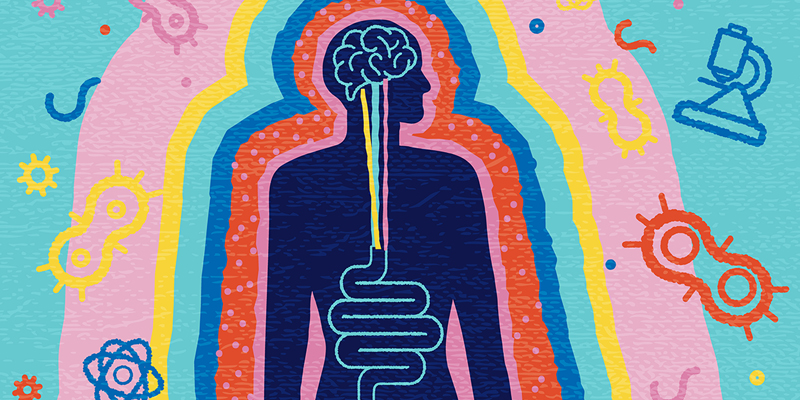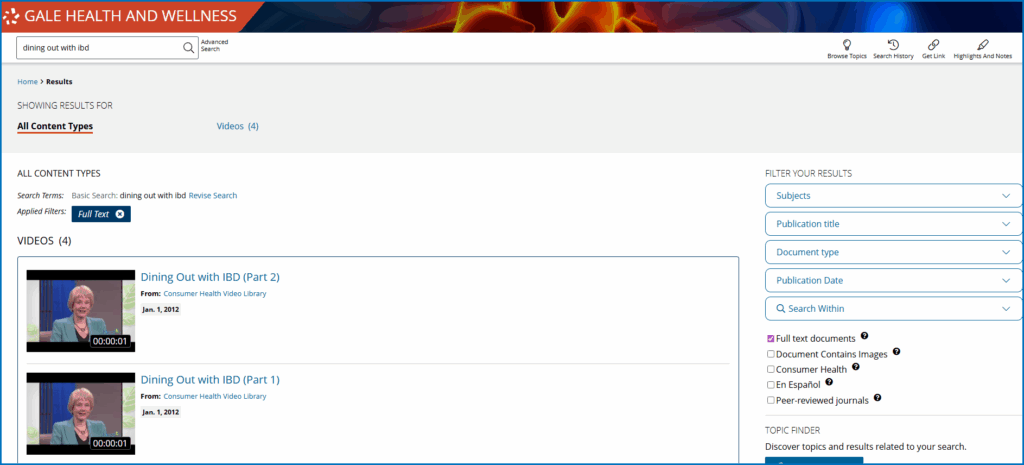|By Gale Staff|
Each day, people living with irritable bowel disease (IBD) face uncertainty about flare-ups—how they could affect work, travel, or plans with friends. While it can feel isolating, it’s important to know that you aren’t alone. Between 2.4 and 3.1 million Americans live with some form of IBD.
IBD is an umbrella term for two distinct diseases: Crohn’s disease and ulcerative colitis. While they share overlapping symptoms, they differ in where and how they cause inflammation. To make matters more confusing, both can resemble irritable bowel syndrome, which affects bowel habits but does not involve chronic inflammation or lasting tissue damage.
From December 1–7, Crohn’s & Colitis Awareness Week drives conversations about the challenges facing people with IBD. To help, Gale Health and Wellness offers reliable content in audio, text, and video formats to ensure community-wide access to critical, medically vetted information. It’s a great starting point to inform and guide conversations in your community about Crohn’s disease and ulcerative colitis.
Inflammatory Bowel Disease: Similar Symptoms, Different Conditions
When a doctor suspects IBD, the first step is to determine whether it’s Crohn’s disease or ulcerative colitis, as each follows a different treatment path. That process can be taxing for patients, involving a battery of tests and long waits for answers.
Part of the difficulty stems from the fact that the two conditions share many of the same symptoms, particularly in the early stages:
- Unpredictable abdominal pain that may be sharp and crampy or dull and achy.
- Chronic diarrhea several times a day, often so disruptive that it interrupts sleep.
- Fatigue, regardless of hours slept, that makes it a challenge to maintain daily routines.
- Unintended weight loss due to reduced appetite and the body’s decreased ability to absorb nutrients through the intestinal wall. Studies have found that as many as 80% of those living with IBD may be malnourished.
- Loss of appetite, which compounds weight loss and nutritional challenges.
These symptoms can appear in different combinations and degrees. Each person’s experience with IBD looks a little different. Gale Health and Wellness gives patrons a trusted place to start exploring their symptoms or preparing for a doctor’s visit.
Crohn’s Disease
Crohn’s disease causes chronic inflammation that can appear anywhere along the digestive tract, though it most often affects the small intestine and the beginning of the colon. The inflammation typically occurs in irregular patches, with healthy tissue adjacent to diseased areas, making it unpredictable to treat.
Another complication is that Crohn’s-related inflammation can penetrate through the entire intestinal wall, sometimes resulting in abscesses—pockets of infection filled with pus—or fistulas, which are abnormal tunnels that connect different parts of the intestine or link the intestine to other organs.
These characteristics result in additional symptoms that reflect its spread and severity:
- Pain that moves depending on where inflammation is active, often worse in the lower right abdomen.
- Painful sores in the mouth.
- Severe cramping, bloating, nausea, or vomiting due to narrowed sections of bowel, slowing or blocking digestion.
Diagnosing Crohn’s Disease
Crohn’s symptoms can overlap with many other gastrointestinal conditions, including ulcerative colitis. To confirm what’s happening, your doctor will usually look at the results of several tests or procedures:
- Blood tests to detect inflammatory cells and infection.
- A stool study to rule out other causes of diarrhea and abdominal pain.
- An endoscopy to view the colon and the end of the small intestine with a camera and collect biopsies of the inflamed tissue. If upper digestive involvement is suspected, an upper endoscopy to examine the stomach and upper small intestine.
- CT or MRI scans to show thickened intestinal walls and the resulting fistulas. An MRI enterography is especially useful for spotting inflammation in the small intestine.
- A capsule endoscopy to capture images of the small intestine that other tests can’t reach. This procedure involves swallowing a pill-sized camera.
Living with Crohn’s Disease
Crohn’s disease cycles between active periods of inflammation, known as flares, and periods of remission without symptoms. Flares may only last a few days, or they might continue for months. The same applies to remission, which can be followed by a sudden return of symptoms with little warning. That unpredictability is part of what makes Crohn’s so challenging to live with.
Treatments aim to both calm active inflammation during flares and maintain remission for as long as possible. Doctors will tailor the particular Crohn’s regimen to the individual patient’s needs.
Diet
Although diet doesn’t cause Crohn’s disease, certain foods can worsen inflammation or irritate the digestive tract during a flare. Some of the most common trigger foods for Crohn’s disease include dairy, fried or greasy meals, spicy dishes, caffeine, and foods high in insoluble fiber like raw vegetables, seeds, or popcorn.
The reason these foods cause problems is that during a flare, the intestinal lining is already inflamed and swollen. With less space for food to pass through the narrowed sections of bowel, irritating foods can make symptoms worse. Spicy meals, for example, contain capsaicin, a natural irritant. Similarly, high-fiber foods have a rough texture that rubs against the swollen lining, adding to pain, bloating, and sometimes bleeding.
Because there’s no universal Crohn’s diet, many patients try an elimination diet—temporarily removing potential triggers, then reintroducing them one by one. If symptoms return, that food may be best avoided, especially during active inflammation.
Keeping a food journal helps patients and their doctors connect what’s happening in the gut with what’s on the plate, making treatment recommendations more personalized.
Learn more about starting a food journal and identifying trigger foods
Medication
Along with changes in diet, doctors can use corticosteroids to calm sudden flare-ups, but these drugs aren’t safe for long-term use because of their side effects.
For ongoing management, providers usually turn to immunomodulators like azathioprine, which can calm an overactive immune system and reduce flare frequency.
Surgery
Even with effective medication, some people with Crohn’s will eventually require surgery to repair narrowed areas of the intestine and remove damaged sections.
While this can’t fully contain the disease—inflammation can recur along the remaining digestive tract—it can provide significant relief to the remaining tissue, and offer substantial benefits afterward, particularly when surgery is combined with continued medical therapy. For some, surgical intervention offers the best chance of restoring daily function and quality of life.
Ulcerative Colitis
Ulcerative colitis differs from Crohn’s disease because its inflammation almost always begins in the rectum—the section of the bowel that holds stool before it leaves the body—and remains confined to the colon. The “ulcerative” part of the name refers to the open sores that develop on the colon’s inner lining.
These distinctions from Crohn’s disease result in a different set of symptoms:
- Diarrhea mixed with blood or mucus, caused by ulcers in the lining of the colon.
- An urgent need to use the bathroom. Because the rectum is inflamed, the body signals “empty now” even when little stool is present, creating sudden, sometimes uncontrollable urges to defecate.
- Abdominal cramps caused by inflamed colon muscles contracting more than usual. The pain often peaks when the urge to go is strongest and improves somewhat after a bowel movement.
- Rectal pain or bleeding that continues even between bathroom trips.
- Chronic fatigue caused by blood loss from ulcers, which depletes iron stores and leads to anemia.
Diagnosing Ulcerative Colitis
Many of the tests used for ulcerative colitis are the same as those for Crohn’s disease, such as blood and stool tests. However, a few diagnostic tools are particularly important for distinguishing between the two:
- Flexible sigmoidoscopy—a shorter, less invasive version of a colonoscopy—to examine the rectum and lower colon.
- Biopsy analysis to confirm continuous inflammation limited to the colon’s inner lining, which contrasts with the patchy, deeper damage often seen in Crohn’s.
- CT or MRI imaging to identify complications such as toxic megacolon, dangerous dilation that prevents the colon from moving waste, or perforations in the intestinal wall.
Living with Ulcerative Colitis
Alongside the physical symptoms, facing the constant, sudden urge to eliminate stool due to ulcerative colitis takes a mental and emotional toll. Many people build their days around restrooms, carrying extra clothing in case of accidents, or avoiding activities altogether.
Treatments can make flares less frequent, and many people find they can enjoy a more normal routine without feeling tethered to the bathroom.
Diet
During remission, many patients try to increase their iron by eating red meat and raw vegetables. That diet is more complicated during a flare because red meat and high-fiber vegetables can irritate the colon, causing diarrhea and pushing nutrients through the body before the body can absorb them.
In addition to taking iron supplements, doctors sometimes recommend a short-term low-residue diet centered on low-fiber foods, such as white rice, bananas, or eggs, that are easier to digest. By slowing stool output and easing irritation, the body has a better chance of absorbing nutrients.
Medications
Ulcerative colitis treatments share immunomodulators and short-term corticosteroid use with Crohn’s disease, but patients also have access to aminosalicylates, a class of drugs designed to calm inflammation in the colon. They can be taken as pills, but many patients use them as enemas or suppositories, which deliver the medication directly to the inflamed tissue during a flare.
The two most common are mesalamine and sulfasalazine. Both block chemical signals that fuel inflammation, ease symptoms, help the colon’s surface heal, and reduce the risk of future flares.
Surgery
When medications no longer control ulcerative colitis, surgery to remove the colon and rectum may be considered.
The most common procedure is ileoanal pouch–anal anastomosis, often called J-pouch surgery. Surgeons remove the colon and rectum, then use part of the small intestine to create a pouch that connects to the anus. This allows patients to pass stool normally, though bowel movements are often looser and more frequent. Strong anal muscles are needed for a J-pouch to work well, and some patients experience leakage or incontinence if those muscles are weak or damaged.
If a J-pouch isn’t an option, doctors may perform an ileostomy, in which the small intestine is connected to an opening in the abdomen and waste empties into an external pouch. Some people struggle with accepting this procedure as a solution because the thought of living with stool collected outside the body can challenge one’s sense of privacy and normalcy.
Still, an ileostomy avoids some of the most challenging aspects of life with a J-pouch. Instead of experiencing six to ten loose bowel movements a day, nighttime urgency, or the risk of accidents, patients can empty the pouch at a time that suits their schedule. It also eliminates the risk of pouchitis—an inflammation of the J-pouch that often feels like ulcerative colitis returning. For some, the trade-off of wearing a pouch is outweighed by regaining control over their bowel movements.
Hear how 24-year-old Lexie faced ulcerative colitis and found confidence living with an ostomy
This Crohn’s & Colitis Awareness Week, public libraries can push back against stigma by offering information that reflects both the medical facts and the lived experiences of people with IBD. With Gale Health and Wellness, patrons can access resources that not only validate what they or their loved ones may be experiencing but also help normalize open, supportive conversations about digestive diseases.
Reach out to your Gale sales representative to learn how a Gale Health and Wellness subscription can support your library in guiding patrons through the complexities of Crohn’s disease, ulcerative colitis, and other chronic health conditions.





